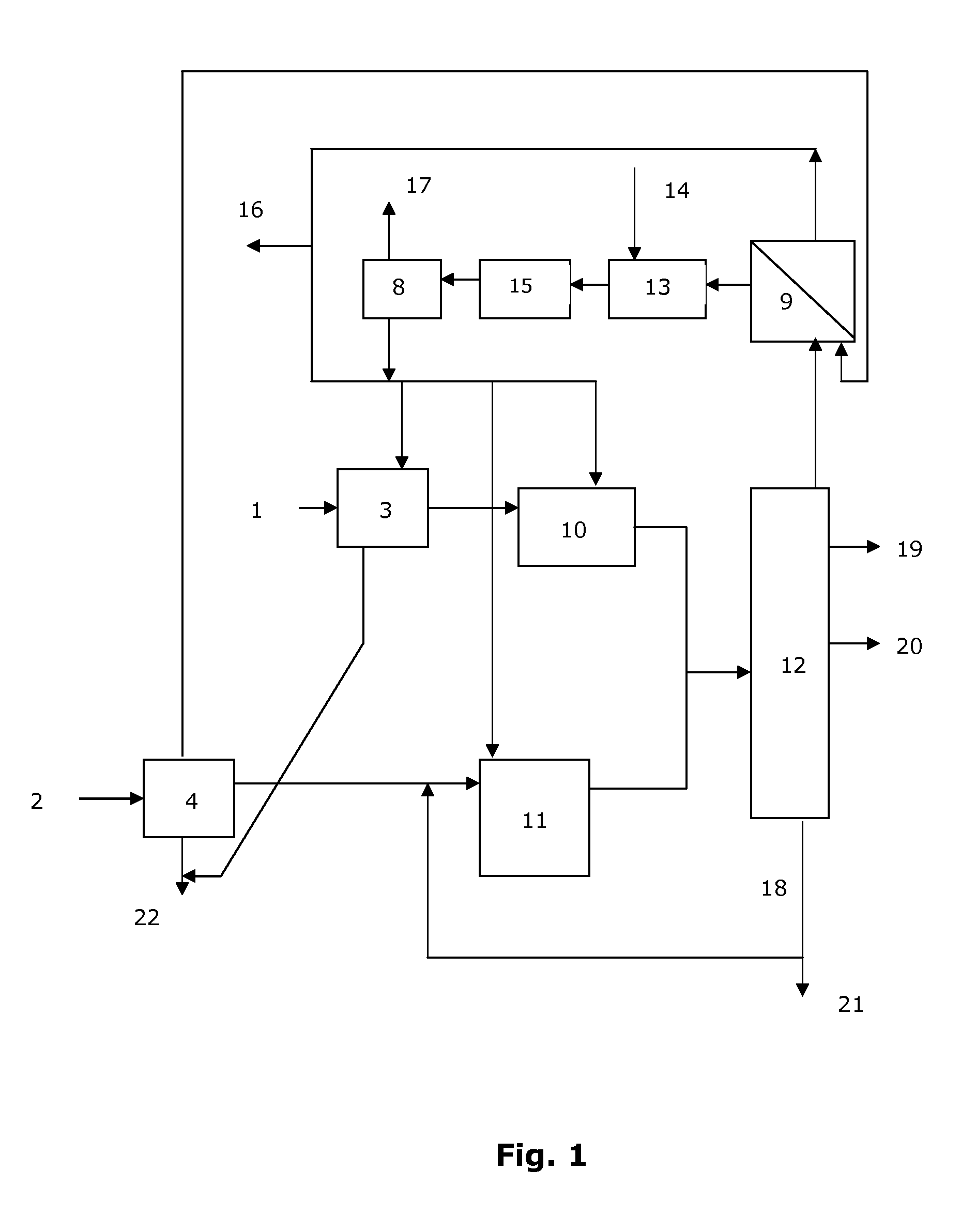Integrated Process for Producing Diesel Fuel from Biological Material and Products, Uses and Equipment Relating to Said Process
a technology of biological materials and products, which is applied in the direction of hydrogen/synthetic gas production, hydrogen from oxygen organic compounds, hydrogen, etc., can solve the problems of restricted use of this method, and achieve the effects of maximizing the utilization of process unit operations, high quality, and superior quality
- Summary
- Abstract
- Description
- Claims
- Application Information
AI Technical Summary
Benefits of technology
Problems solved by technology
Method used
Image
Examples
example 1
[0084]FIG. 1 shows a schematic flow diagram of an integrated process operating according to the invention. The integrated process facilities are located in close connection with a Kraft pulp mill. The two main processes of the invention comprise production of the HDO hydrocarbons by the unit operations 1, 3, 10 and the FT hydrocarbons by the unit operations 2, 4, 11. The hydrocarbons are combined in separation unit 12 and a desired product fraction is recovered at 20.
[0085]A feed of biological hydrocarbons comprising crude tall oil from the Kraft mill is optionally thermally refined at 1 and is passed to catalytic HDO reactor 3 charged with a standard hydrodeoxygenation / desulphurization catalyst based on CoMo / Al2O3. In an alternative embodiment, a NiMo / Al2O3 catalyst is used. The saturated normal paraffins from the HDO reactor 3 have a chain length within the desired diesel or middle distillate range of C11 to C20 and, in the case of tall oil, the fatty acids are predominantly C15 t...
example 2
[0096]An integrated process using tall oil fatty acid (TOFA) as HDO feed and synthesis gas from wood slash, waste wood and bark as FT feed is operated in the process facilities described in Example 1. The two hydrocarbon streams (I.) and (E.) are mixed and distilled to provide a middle distillate (M.), a naphtha fraction (N.), a top fraction (O.) and a bottom fraction (S.), The top fraction is directed to the hydrogen recovery process and the bottom fraction is recirculated to the cracking / isomerization 11.
[0097]FIG. 2 shows the measurement points for the mass balances in the flow chart of FIG. 1. The amounts of feeds and product as well as the mass balances along the measurement points A. to S. are indicated in Table 1 below. The unit kt / a indicates kilo tons (1000 metric tons) per year.
[0098]The mass balance shows that the desired product fraction of diesel fuel (M.) is the largest product fraction. Due to the high level of C18 hydrocarbons in the TOFA feed to the HDO reactor, the...
example 3
[0099]The fuel production equipment according to Example 1 is integrated with a pulp and paper mill. Waste biomass from the pulp mill is used to produce synthesis gas for the Fischer-Tropsch reaction. Tall oil fatty acid (TOFA) from the pulp mill tall oil production facilities is used directly in the HDO reactor to produce n-paraffins. Waste water from the fuel process is directed to the water treatment unit of the pulp and paper mill. Hydrogen sulfide from the synthesis gas production and from the HDO is fed directly into the sulfur recovery and recirculation system of the pulp mill. Energy produced in the exothermic FT reaction is fed to the paper mill and used for drying of paper.
[0100]Three different ratios of TOFA and synthesis gas are used as indicated in Table 2. A middle distillate boiling at 175° C. to 350° C. is recovered as a diesel fuel fraction in the separator 12. The top fraction comprises C1-C4 hydrocarbons and other gases including hydrogen. This light fraction is s...
PUM
| Property | Measurement | Unit |
|---|---|---|
| temperature | aaaaa | aaaaa |
| operating pressure | aaaaa | aaaaa |
| operating temperature | aaaaa | aaaaa |
Abstract
Description
Claims
Application Information
 Login to View More
Login to View More - R&D
- Intellectual Property
- Life Sciences
- Materials
- Tech Scout
- Unparalleled Data Quality
- Higher Quality Content
- 60% Fewer Hallucinations
Browse by: Latest US Patents, China's latest patents, Technical Efficacy Thesaurus, Application Domain, Technology Topic, Popular Technical Reports.
© 2025 PatSnap. All rights reserved.Legal|Privacy policy|Modern Slavery Act Transparency Statement|Sitemap|About US| Contact US: help@patsnap.com



